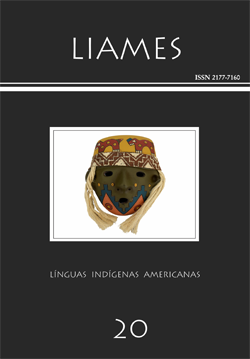Abstract
Aymara is an Amerindian language spoken mainly in Peru and Bolivia. To date, relatively little is documented about Aymara verbal art. Accordingly, we analyze a traditional song recorded in the Peruvian highlands. We provide a musical and linguistic analysis of the non-prosodic poetic song structure. We detail the octosyllabic, homeoteleutonic strategies for line formation, the melodic and rhythmic characteristics, and outline the syntactic, morphological, and semantic strategies used in forming semantic couplets. This reveals semantic categories which would not be apparent in a traditional linguistic analysis. Furthermore, the musical analysis confirms previous works on the misperception of a musical anacrusis. We conclude that rigorous, scientific analyses of verbal art require consideration of the construction of meaning through practice and dialog.
References
Arnold, Denis Y. (2014). Los ritmos del textil: Comparaciones entre las formas cantadas y tejidas de las tejedoras amerindias. Jornadas Andinas de Literatura Latinoamericana 11: 2014, 4-8: Heredia, Costa Rica. Disponible en: https://vdocuments.mx/los-ritmos-del-textil.html
Arnold, Denis Y.; de Dios Yapita, Juan (1998). Río de vellón, río de canto. Cantar a los animales, una poética andina de la creación. La Paz. Bolivia: Facultad de Humanidades y Ciencias de La Educación. Carrera de Literatura. Universidad Mayor de San Andrés.
Beyersdorff, Margot (1986). La tradición oral quechua vista desde la perspectiva de la literatura. Revista Andina 4: 213–236.
Boodberg, Peter Alexis (1955). Syntactic metaplasia in stereoscopic parallelism. In Alvin P. Cohen (1979) (ed.), Selected works of Peter A. Boodberg, pp. 184-185. Berkeley: University of California Press.
Classen, Classen (1990). Sweet colors, fragrant songs: Sensory models of the Andes and the Amazon. American ethnologist 17(4): 722-735. https://doi.org/10.1525/ae.1990.17.4.02a00070
Coler, Matt (2014). A grammar of Muylaq’ Aymara: Aymara as spoken in Southern Peru. Leiden: Brill. https://doi.org/10.1163/9789004284005
Coler, Matt; Nicholas Q. Emlen; Edwin Banegas-Flores (2020). Vowel deletion in two Aymara varieties. Italian Journal of Linguistics 32(1): [To appear]
d’Harcourt, Raoul & Marguerite (1925). La musique des Incas et ses survivances. Paris: Librairie Orientaliste Paul Geuthner.
Fabb Nigel (2017). Linguistics and literature. In Mark Aronoff; Janie Rees-Miller (eds.), The handbook of linguistics, pp. 446-465. John Wiley & Sons, Ltd. https://doi.org/10.1002/9781119072256.ch22
Fox, James J. (1977). Roman Jakobson and the comparative study of parallelism. In D. Armstrong; C.H. van Schooneveld (eds.), Roman Jakobson, echoes of his scholarship, pp. 59-90. Lisse: Peter de Ridder.
Herder, Johan Gottfried von (1782 [1993]). Vom Geist der Ebräischen Poesie: Eine Anleitung für die Liebhaber derselben, und der ältesten Geschichte des menschlichen Geistes i Werke in zehn Bänden, 5.
Jakobson, Roman (1966). Grammatical parallelism and its Russian facet. In Krystyna Pomorska; Stephen Rudy (eds) (1987), Language in literature, pp. 145-179. Cambridge: Harvard University Press.
Karttunen, Frances; Lockhart, James (1980). La estructura de la poesía náhuatl vista por sus variantes. Estudios de cultura náhuatl 14: 15-64. Available at:
http://www.historicas.unam.mx/publicaciones/revistas/nahuatl/pdf/ecn14/204.pdf
Levin, Samuel R. (1962). Linguistic structures in poetry (Janua Linguarum 23). The Hague: Mouton.
Lowth, Robert (1829). Lectures on the Sacred Poetry of the Hebrew Scriptures. New York: J. Leavitt.
Mannheim, Bruce (1987). Couplets and oblique contexts: The social organization of a folksong. Text-Interdisciplinary journal for the study of discourse 7(3): 265–288. https://doi.org/10.1515/text.1.1987.7.3.265
Mannheim, Bruce (1998). “Time, not the syllables, must be counted”: Quechua parallelism, word meaning, and cultural analysis. Michigan discussions in anthropology 13(1): 238-281.
Mannheim. Bruce (2015). All translation is radical translation. In Carlo Severi; William F. Hanks (Eds.), Translating worlds: The epistemological space of translation (Special issues in ethnography theory series), pp. 199-219. Chicago: Hau Books.
Mannheim, Bruce; Vleet, Krista E. Van (1998). The dialogics of southern Quechua narrative. American Anthropologist 100(2): 326–346.
Pigott, Charles M. (2013). The lyrical creation of community: song as a catalyst of social cohesion in Andean Peru. AlterNative: An International Journal of Indigenous Peoples 9(4): 335-350.
Sperber, Dan; Wilson, Deirdre (1990) Rhetoric and relevance. In John. Bender; David Wellbery (Eds.), The ends of rhetoric: History, theory, practice, pp. 140- 156. Stanford CA: Stanford University Press.
Stobart, Henry (2006). Music and the poetics of production in the Bolivian Andes. Ashgate Publishing, Ltd.
Stobart, Henry; Cross, Ian. (2000). The Andean Anacrusis? British Forum for Ethnomusicology 9: 63–92.
Tedlock, Dennis (1974). trans. 1985. Popol Vuh: The Mayan book of the dawn of life. New York: Touchstone.
Turino, Thomas (1989). The coherence of social style and musical creation among the Aymara in Southern Peru. Ethnomusicology 33(1): 1-30. Available in: http://www.jstor.org/stable/852167
Urton, Gary (1997). The social life of numbers: A Quechua ontology of numbers and philosophy of arithmetic. Austin: University of Texas Press.
Waugh, Linda R. (1982). Marked and unmarked: A choice between unequals in semiotic structure. Semiotica 38(3-4): 299--318. https://doi.org/10.1515/semi.1982.38.3-4.299

This work is licensed under a Creative Commons Attribution-NonCommercial 4.0 International License.
Copyright (c) 2020 Matt Coler, Patrice Guyot, Edwin Banegas-Flores


